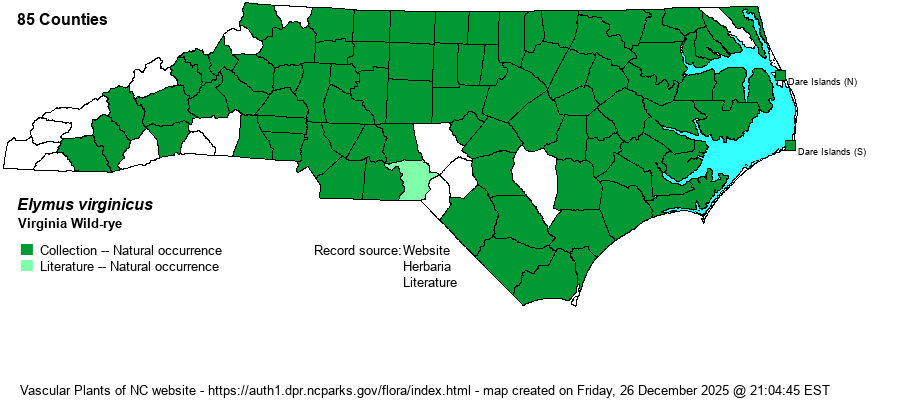| Section 5 » Order Cyperales » Family Poaceae |
Show/Hide Synonym
| taxonName | relationship | relatedTaxonName | relatedTaxonRefText | relComments |
|---|
|
| Elymus virginicus | = | Elymus virginicus var. virginicus | Flora of North America (1993b, 1997, 2000, 2002a, 2002b, 2003a, 2004b, 2005, 2006a, 2006b, 2006c, 2007a, 2009, 2010) | | | Elymus virginicus | = | Elymus virginicus var. virginicus | | | | Elymus virginicus | < | Elymus virginicus | Gleason and Cronquist (1991) | | | Elymus virginicus | < | Elymus virginicus | Godfrey and Wooten (1979, 1981) | | | Elymus virginicus | < | Elymus virginicus | Radford, Ahles, and Bell (1968) | | | Elymus virginicus | < | Elymus virginicus | Flora of Virginia | | | Elymus virginicus | < | Elymus virginicus | Wofford (1989) | | | Elymus virginicus | < | Elymus virginicus | Flora of West Virginia | | | Elymus virginicus | < | Elymus virginicus var. virginicus | Fernald (1950) | | | Elymus virginicus | < | Elymus virginicus var. virginicus | Gleason (1952) | | | Elymus virginicus | < | Elymus virginicus var. virginicus | | | | Elymus virginicus | < | Elymus virginicus var. virginicus | | | | Elymus virginicus | < | Elymus virginicus var. virginicus | Small (1933, 1938) | | | Elymus virginicus | ? | Elymus striatus | Small (1933, 1938) | | | Source: Weakley's Flora |
|
| Author | L. | |
| Distribution | Throughout the state? Note: with the resurrection of E. glabriflorus, all NC records of E. virginicus need to be re-checked. The current map is very likely to lose a number of counties. As example, only the following counties at UNC Chapel Hill were annotated by Julian Campbell as E. virginicus sensu stricto: Alamance, Avery, Chatham, Cherokee, Cumberland, Edgecombe, Franklin, Lee, Orange, Polk, Washington, Yancey. However, the Digital Atlas of the Virginia Flora website says: "The status of the four vars. [halophilus, virginicus, and two not found in NC] has not been determined, although field and herbarium studies suggest that var. virginicus is common and widespread over the full range of habitats in the state." And, note also that E. glabriflorus and E. macgregorii have already been pulled out of E. virginicus and mapped separately on that website. It may be that the situation in NC is similar as in VA, but herbarium specimens of "virginicus" should be annotated first.
Newf. to Sask., south to northern FL and TX. | |
| Abundance | Considered as common statewide in VA, and should be considered in NC as common in the Coastal Plain and Piedmont, and fairly common in the Mountains, until further notice. | |
| Habitat | Floodplain forests and bottomlands, both brownwater and blackwater. Sometimes also found on moist slopes, clearcuts, and wet roadsides. | |
| Phenology | Flowering and fruiting July-September. | |
| Identification | This the prototypical wild-rye, with stems 2-3 (-4) feet tall, well-spaced leaves, and a terminal, erect inflorescence. The recent recognition of E. glabriflorus and E. macgregorii means that previous records of E. virginicus need to be double-checked for ID. From E. virginicus, E. glabriflorus and E. macgregorii are told by their wider inflorescences (including awns) being 2.2-4.5 cm wide vs. 0.7-2.2 cm wide in E. virginicus, and glume awns being 10-30 mm long (vs. 0-10 mm long in E. virginicus). | |
| Taxonomic Comments | Elymus glabriflorus and E. macgregorii have been split off; see FNA for treatments. Weakley (2020) recognizes E. hirsutiglumis, a single 1957 NC specimen from Robeson County. It previously had been treated as a variety or even a forma of virginicus and we believe it is merely a minor variant.
Ryegrasses or Wild-ryes (genus Elymus) are noted by their evenly spaced leaves and elongate, terminal inflorescence that recall cultivated rye or wheat. Each floret produces several long, skinny awns (shortest in E. virginicus sensu stricto). Identification of some species requires a dissecting scope or at least a 10x handlens. | |
| Other Common Name(s) | None | |
| State Rank | S5 | |
| Global Rank | G5 | |
| State Status | | |
| US Status | | |
| USACE-agcp | FAC link |
| USACE-emp | FACW link |

